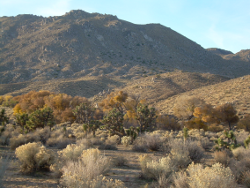- Data Basin |
- Use Cases |
- Southern Sierra Partnership
Southern Sierra Partnership

Explore related items…
Framework for Cooperative Conservation and Climate-adaption
The Southern Sierra Partnership (SSP) is an alliance formed in 2009 by Audubon California, the Sequoia Riverlands Trust, the Sierra Business Council, The Nature Conservancy, and later joined by the Conservation Biology Institute. This group engaged in a collaborative conservation planning process for the southern Sierra and Tehachapi Mountains (southern Sierra). This planning process took a rigorous approach to incorporating climate change into conservation planning.
The SSP along with representatives from ten agencies and organizations characterized biodiversity and ecosystem services, examined climate change projections, and assessed existing and future threats to biodiversity. The SSP developed a regional conservation area design and regional and project-scale conservation strategies for both public and private lands in the southern Sierra and Tehachapi Mountains.
The SSP presents this regional vision and five-year action plan to spur collective action and greater coordination amongst the diverse stakeholders across the region. Regional collaboration will be essential to conserving the exceptional biological diversity and ecosystem services of the southern Sierra and Tehachapis in the face of accelerating and interacting threats, including climate change. There is momentum for action: Some parts of the plan are already being implemented.
The regional design process helps to identify areas that allow connectivity across habitat types, physiographic regions, and land ownerships, especially for wide-ranging and migratory species. Preserving connectivity in this region is critical to support wildlife population viability, maintain critical ecological processes, and mitigate the negative effects of fragmentation. Wildlife move within and between suitable habitat for many reasons at multiple spatial and temporal scales. In addition, maintaining movement pathways for plant species’ seed dispersal and longer-term range shifts is important for long-term viability under a changing climate. Given this, it is important to maintain connectivity within and across multiple habitats and across latitudinal, elevational, and climatic gradients.
 There are several ways in which the regional conservation design incorporates habitat connectivity.
There are several ways in which the regional conservation design incorporates habitat connectivity.1. Suitability layer and Marxan settings: The suitability, or cost, layer reasonably represents intactness in this region at a broad scale. Areas that have higher suitability scores were preferentially selected over areas that are more degraded. In addition, the model promotes clumping of selected areas to minimize edge habitat in conservation areas.
2. Subregions: By forcing Marxan to select areas across major physiographic zones to meet representation goals, the regional conservation design promotes connectivity across environmental gradients.
3. Riparian connectors: Riparian areas in this region provide movement pathways for fish and wildlife, nutrients, and water. Because they are often the only habitats in the valley floor and foothills with adequate natural cover, they serve the movement needs for larger animals, such as mountain lion. We included perennial and other streams and rivers identified as important in other planning processes to provide east/west and elevational connectivity in the region.
4. Expert input, other studies: We added planning units as the top priority (core areas) in the regional design that are known to be important for wildlife movement, based on field observations, feasibility, and other factors.
For more information, contact: Susan Antenen, Conservation Biology Institute
Photo credits: Susan Antenen
- Citation
- Susan Antenen. 2010. Southern Sierra Partnership. In: Data Basin. [First published in Data Basin on Sep 14, 2010; Last Modified on Feb 2, 2013; Retrieved on Jan 6, 2026] <https://databasin.org/articles/c23d105728b94cf6b2a96f12d84cdf73/>
About the Author

Conservation Planner; Coordinator of the Southern Sierra Partnership

